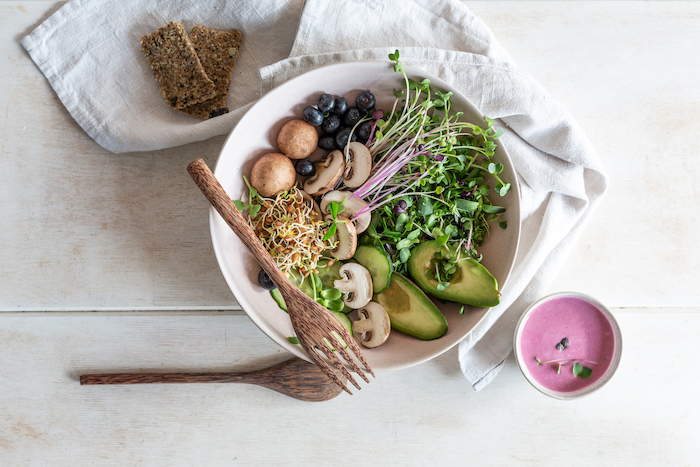Yoga, Ayurveda and raw food – do they go together? Most people associate yoga and the Ayurvedic diet with cooked food and Indian spices.
Nevertheless, more and more yogis are now swearing by raw food and are experiencing more flexibility and a clearer mind by changing their diet. How can this be explained, and can a largely raw vegan diet be combined with Ayurveda?
CONTENT
Yoga – A Little Introduction
Yoga is a philosophical teaching that originated in India over 2,000 years ago. The word itself comes from Sanskrit, meaning “unity and harmony”
Yoga was originally a purely spiritual path whose main goal was the search for enlightenment. The most important aspects were described by the yogi Patanjali in the Yoga Sutra in 8 disciplines.
The Eightfold Path:
1. Yama: Rules of conduct and moral discipline
2. Niyama: Self-discipline
3. Asanas: Physical exercises
4. Pranayama: Breathing techniques
5. Pratyahara: Withdrawal into one’s own mind
6. Dharma: Compliance with rules for coexistence
7. Dhyana: Meditation
8. Samadhi: Enlightenment
Yoga is a very far-reaching philosophy of life. The yoga practice offered in the Western world, consisting of physical and breathing exercises as well as relaxation and meditation, only covers a small part of what yoga fully consists of.
The effects of practicing yoga can be remarkable. When practiced regularly, the exercises promote vitality, quality of life and balance. They also help to improve physical and mental flexibility, lead to more awareness of oneself and one’s surroundings and are therefore an ideal balance to today’s fast-paced, chaotic everyday life.
Connection Between Yoga and Nutrition
As the body becomes increasingly sensitive, most yoga practitioners also feel the need to adjust their eating habits. In turn, with a more conscious diet, the flow of energy becomes purer, movements become smoother, thoughts become clearer and the body becomes brighter.
What principles can explain this development?
As a yogi, if you take a closer look at a healthy diet, you’ll quickly come across the philosophy of the three-part nutritional system according to the Gunas. In the Yoga Sutra, the yogi Patanjali describes “the principle of purity – internally and externally” as a fundamental rule of conduct. Nutrition plays an essential role and can be attributed to three basic properties of nature, the Gunas.
The three Gunas:
- Sattva (purity and awareness)
Food should be pure, produced without violence (Ahmisa) and consciously selected and consumed. All fresh, natural foods such as ripe fruits, leafy greens, vegetables, seeds and nuts meet this requirement. - Rajas (activity und restlessness)
Hectic or chaotic eating, hot spices such as pepper and chili or bitter, sour, salty and dry foods are considered rajasic. This also includes unripe fruits, coffee, cocoa, refined sugar, white flour and other isolated carbohydrates. These foods make the body and mind restless and give the illusion of energy that’s actually anticipated from the future and is later missing. - Tamas (inertia )
Onions, garlic, fermented foods, mushrooms, animal foods and alcohol are considered tamasic. They’re considered rather difficult to digest, make you sluggish and have a slightly toxic effect. Leftover food from the day before, frozen food, fast food and too much or too little food also have a reducing effect. On the other hand, they can support stability, relaxation, silence, depth and good sleep.
All three Gunas are present in everything. Each food is assigned to one of the three qualities and by consuming it we absorb the corresponding energy. The yogi’s goal is a purified body and mind through Sattva, the achievement of which can be supported by a peaceful, cleansing, and balanced diet.

The Sattvic Quality of Fresh Plant Foods
There’s no doubt that the most original form of human nutrition consists of plant foods – freshly harvested and unprocessed. A diet that’s as natural as possible is pure and promotes a conscious, mindful connection to nature. It enables non-violent and responsible consumption that goes far beyond the food itself.
Sun food
When freshly harvested, we can also describe plant-based foods, especially green leafy vegetables, as sunny foods. The green plant pigment, chlorophyll, absorbs light particles (photons) during photosynthesis. Together with carbon dioxide and water, it converts sunlight into glucose and oxygen and stores these in green leaves. So, fresh leaves are like a kind of storage battery for sunlight. Consuming fresh, green foods can significantly support the development of a lighter body. During the assimilation process, this light is released by the plants and absorbed by our bodies. In addition, it’s assumed that biophotons improve the transfer of information between the body’s cells and have organizing power.
Plant cell water
Water-rich vegetables such as cucumbers, ripe fruits and freshly squeezed juices provide us with valuable plant cell water, are unadulterated, rich in nutrients and have a cleansing and hydrating efect. They’re rich in nutrients in a natural, active ingredient complex and contain as few substances as possible that put a strain on our bodies or cause elimination crises.
Wild herbs, sprouts and microgreens
Wild herbs, sprouts and microgreens also have an extraordinary abundance of secondary plant
substances and enzymes. Wild herbs find their own place in nature, establish themselves and as a result, have plenty of protective and defensive substances in the form of secondary plant substances. According to current knowledge, secondary plant substances have a health- promoting influence on a variety of metabolic processes and have, among other things, antibiotic, anti-inflammatory and immune-modulating effects.
In winter, sprouts and microgreens are ideal for providing us with plenty of vitamins, minerals, biophotons and enzymes. While leafy greens and vegetables from the supermarket are subject to significant nutrient losses through storage, sprouts and microgreens grow on our own windowsill and can reach our plates fresh and alive.
Sweetness
The Sattvic diet is characterized by a sweet or earthy taste. Preferred foods are fruits and starchy vegetables such as carrots, sweet potatoes or lentil sprouts. Anything that tastes spicy produces Rajas and salty dishes lead to heaviness, i.e. more Tamas in the body. Therefore, in the Sattvic diet we find no garlic, no chili and little salt.
The choice of food has a great influence on our well-being. Our health and spiritual
development can be significantly promoted through a Sattva-dominant diet. Fresh, plant-based
foods contain their full potential of “light” and life energy (prana), have a cleansing
and invigorating effect and help us to feel physically nourished and mentally organized.
The choice of food has a great influence on our well-being. Our health and spiritual
development can be significantly promoted through a Sattva-dominant diet. Fresh, plant-based foods contain their full potential of “light” and life energy (prana), have a cleansing and invigorating effect and help us to feel physically nourished and mentally organized.
Practical Implementation
Under no circumstances should you start changing your diet with the optimum in mind, but rather slowly introduce the Sattvic diet and gradually reduce Rajas and Tamas.
Switching too quickly to a “pure” diet can trigger detoxification crises, while sudden caffeine or sugar withdrawal causes stress and throws the body out of balance. It’s also important to slowly get your digestion used to a diet that consists of plenty of fresh plant foods. This gives the intestinal bacteria enough time to rearrange themselves in order to optimally digest the increased plant content.
Listen to your body
The ultimate goal should be to find the right amount of “pure nutrition” for yourself. A diet that requires a lot of discipline doesn’t make sense in the long run because it cannot create real inner peace. It’s better to integrate Sattva into your life to the extent that it feels easy and brings joy. At best, a ball will start rolling that can’t be stopped.
In order to get to know yourself better, it’s very helpful to assign your individual constitution to an
Ayurvedic doshas.
Essential Aspects of Ayurveda
Ayurveda or Ayus (life) and Veda (knowledge) – “knowledge of life” – is the oldest traditional healing knowledge and finds its origins in the advanced Vedic culture of India. Knowledge was once transmitted orally from generation to generation. The holistic concept of life teaches how health can be maintained well into old age through a balanced relationship between body, soul and spirit.
Five Elements and The Doshas
According to Ayurveda, in nature, we find five elements that shape our personal natures or characteristics: air, water, fire, earth and ether. Further, these are combined into three bioenergies, called “doshas” in Sanskrit. These are biological control forces whose properties have a lasting influence on us:
Vata = Air + Ether
Pitta = Fire + Water
Kapha = Earth + Water
Are you interested in gaining a comprehensive understanding of the health benefits of a plant-based diet? Download the curriculum for our Holistic Nutrition Coach training program.
It’s assumed that the three doshas are always working in the body at the same time, but each of us has a slightly different nature from birth. The individual basic constitution is then assigned to a single dosha type (Vata, Pitta or Kapha) or a mixed type (such as Vata-Pitta or Pitta-Kapha)
The following description of the dosha types enables a rough classification with indications of an appropriate diet.
Nutrition for Vata types
The Vata type is slim, has a light bone structure and rather weak muscles, tends to have dry skin, gets cold easily and has difficulty gaining weight. As a rule, Vata people have an easy digestive fire. Flatulent, difficult-to-digest foods such as cabbage, mushrooms and legumes should be avoided. Easily digestible and warm foods that taste salty, sour or sweet are recommended; suitable spices include cinnamon, cloves, ginger and saffron.
Nutrition for Pitta types
The Pitta type has an athletic body, warm skin, a lot of energy, a strong will and likes to take on leadership tasks. Pitta people should relax enough and avoid all acidic and spicy foods, as well as alcohol, coffee, dairy products, sugar and white flour. Instead, cool and light foods as well as bitter and sweet foods are recommended. Suggested spices are spices turmeric, coriander and cardamom.
Nutrition for Kapha types
The Kapha type is strong and has plenty of stamina and composure. Kapha people tend to be overweight, have a slow metabolism and have a rather sluggish digestion. Fatty, heavy meals should be avoided and instead, lots of fresh fruit and vegetables should be eaten. According to Ayurvedic nutrition, Kapha-type food should be light and dry and contain spicy, bitter and tart flavors. Chili and ginger are recommended.
Digestive Fire
In Ayurveda, the digestive fire or “Agni” is very important. The better our digestion is, the healthier we are. A strong digestive fire occurs when an optimal amount of digestive juices and stomach acid are produced and released by the glands. Stomach acid is particularly important for protein breakdown. A lack of stomach acid manifests itself in the form of flatulence, constipation, bloating, heartburn and belching.
Ways to strengthen the digestive fire:
- Ginger water – boosts your metabolism and thus strengthens our Agni
- Bitter substances – not only stimulate saliva but also stimulate the production of digestive juices and have an activating effect on the liver and pancreas
- A diet that balances your personal Dosha type
- Digestive spices such as ginger, cardamom, coriander, cumin, turmeric, nutmeg, cloves and cinnamon
Ayurvedic Nutrition Rules
The following basic Ayurvedic recommendations support the Sattvic lifestyle:
- Choose your food consciously, if possible seasonally and regionally.
- Prepare your dishes carefully.
- Only eat when you are truly hungry.
- Eat the largest meal at midday, when the digestive fire is strongest.
- Chew thoroughly and salivate your food well.
- Don’t overeat.
- Only consume fresh and ripe foods.
- Mix foods as little as possible.
- Eat light and digestible food in the evening.
- Don’t go to bed on a full stomach.
- Restful sleep is the best prerequisite for regeneration.
Ayurveda and Raw Food
The purest form of nutrition undoubtedly consists largely of fresh, plant-based foods. To ensure that raw food nutrition is successful in the long term, the basic principles of yoga and Ayurveda can be a great enrichment for individual, type-appropriate adaptation. They can also provide very insightful explanations as to why our needs and comfort zones are often so different.
All three Gunas (Sattva, Rajas and Tamas) as well as the three Doshas (Vata, Pitta and
Kapha), the individual digestive fire and the Ayurvedic nutritional rules provide valuable inspiration for finding out the right raw food diet for you.
Our Recommendations
Our recommendations are based on the nutritional theory of Dr. Gabriel Cousens, author of many books on nutrition and conscious eating.
Dr. Gabriel Cousens is a holistic doctor, psychiatrist and spiritual teacher. In his books, he succeeds like no other author in presenting an individual type-appropriate diet by combining Ayurvedic and raw vegan nutrition while incorporating the latest scientific findings.
The Vata Type
The Vata type has the weakest digestive fire of all three dosha types and is the most prone to freezing or feeling cold. Therefore, certain aspects should be taken into account when implementing a raw food diet.
First of all, it’s important to eat at regular times, not to take too long between meals and to eat your largest meal at lunchtime, because this is when the digestive fire is strongest. In general, Vatas should choose fewer foods that have a cooling effect. Fruits and vegetables should not be eaten straight from the refrigerator. In winter it makes sense to serve raw food meals in warmed dishes or to warm the food up to 40 degrees Celsius (105 degrees Fahrenheit).
Breakfast, for example, should consist of a delicious raw buckwheat porridge made from sprouted buckwheat with warming spices. A pure fruit meal can easily unbalance Vata types, so in order to stabilize themselves, they should always combine fruits with plenty of leafy greens (minerals).
Lunch can consist of a large salad or bowl with avocado, olives, falafel and/or raw vegetable crackers with hummus. The evening meal recommended for the Vata type is cooked, like vegetable soup or steamed vegetables with quinoa or millet. Vatas tolerate fats and salt best of the Dosha types.
The Pitta Type
Pitta types have the strongest digestive fire and usually cope best with a raw food diet.
Due to their rather hot temperament, Pitta types should avoid spicy, oily and salty dishes as well as stimulating foods such as coffee and alcohol. Instead, mild, sweet, bitter and, depending on the degree of cleansing of the body tissue, low-fat raw food dishes are ideal. Raw food can make up 80-100% of their diet, although raw food should not be consumed late in the evening.
Breakfast can consist of fruits or a green smoothie. At lunchtime and in the evening, Pittas can enjoy the raw vegan kitchen with bowls, wraps, zoodles and much more. Of all three Doshas, Pittas are the most sensitive to toxins from water, air and food and should therefore pay particular attention to organically grown food and good water quality.
The Kapha Type
Kaphas are in many ways the opposite of the Vatas. Due to their stable body tissue, Kapha types have a rather sluggish digestion. They should avoid oily and fatty foods as these slow down the digestion process. Kaphas thrive on an 80-100% raw food diet and can even survive on just one or two meals a day.
Breakfast can be skipped, lunch can consist of water-rich fruits and vegetables, low in salt, seeds or nuts. In addition, Kaphas can tolerate lots of bitter and astringent green vegetables as well as hot spices. Too much fat and salt can cause the Kapha type to feel unpleasantly bloated; instead, they can achieve optimal balance through a light diet.
More articles on this topic:
Would you like to join our unique, based on nutritional sciences and practice-oriented training program for gaining a high level of health?
We are more than happy to inform you about our training program on our website!






0 Comments